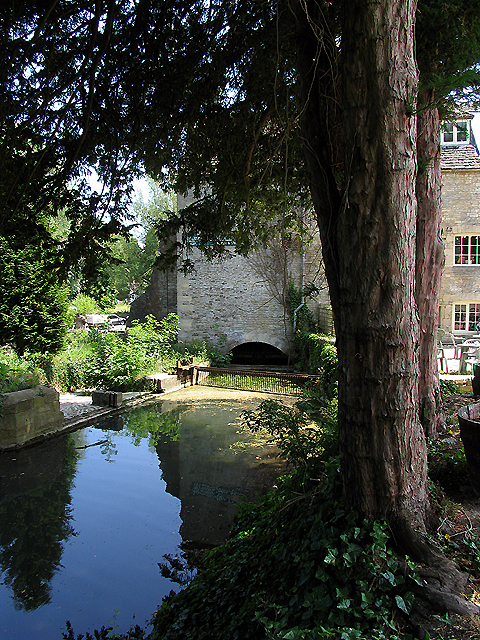Bibury
From Wikipedia, the free encyclopedia
For steamships named Bibury, see SS Bibury.
Coordinates: 51.758°N 1.832°W| Bibury | |
 Arlington Row: Cotswold stone cottages |
|
|
|
|
| OS grid reference | SP1106 |
|---|---|
| Civil parish | Bibury |
| District | Cotswold |
| Shire county | Gloucestershire |
| Region | South West |
| Country | England |
| Sovereign state | United Kingdom |
| Police | Gloucestershire |
| Fire | Gloucestershire |
| Ambulance | Great Western |
| EU Parliament | South West England |
|
|
The Church of England parish church of Saint Mary is Saxon with altar additions.[2] From AD 1130 until the English Reformation, it was a peculier of Osney Abbey in Oxford.[2] Adjacent to the church is the village primary school whose building was originally built in the 1850s. The school currently[when?] has around 30 pupils in 2 classes. On the Arlington (west) side of the village is Arlington Baptist Church, where a congregation has been meeting since the 1740s.[3]
The artist and craftsman William Morris called Bibury "the most beautiful village in England" when he visited it.[4] Its honey-coloured 17th century stone cottages with steeply pitched roofs once housed weavers who supplied cloth for fulling at nearby Arlington Mill. The Mill is now a private residence. [5]
The picturesque Arlington Row cottages were built in 1380 as a monastic wool store. This was converted into a row of weavers' cottages in the 17th century. The cloth produced there was sent to Arlington Mill. Arlington Row is probably one of the most photographed Cotswold scenes, and was preserved by the Royal College of Arts. It has been used as a film and TV location — most notably for Stardust and Bridget Jones Diary.[6]
The River Coln flows alongside the main street. Its water, along with the Bibury Spring, supplies Bibury Trout farm, founded in 1902, by the famous naturalist Arthur Severn, to stock the local rivers and streams with the native Brown Trout. The hatchery spawns up to 6 million trout ova every year.[7]
Late in the 19th century George Witts recounted the discovery of the Bibury Roman villa:
In the year 1880 a Roman villa was accidentally discovered in the parish of Bibury, about six miles northeast of Cirencester. Some Roman pottery, coins, remnants of tesselated pavements, &c., were found, but as no examination has yet taken place, no description of the building can be given.
— George Witts, 1883, [8]
References
- ^ Croome, W.I. (c. 1992). A Short History of St Mary's Bibury. Gloucester: The British Printing Company Ltd. OCLC 78092632.
- ^ a b Verey, David (1970). The Buildings of England: Gloucestershire: The Cotswolds. Harmondsworth: Penguin Books. pp. 106–112. ISBN 0-14-071040-X.
- ^ Arlington Baptist Church Website
- ^ Gibbs, J.A. (1898). A Cotswold Village. VCH Glos. p. 23.
- ^ "Top 15 unusual buildings for sale". Daily Telegraph.
- ^ IMDB Website
- ^ Bibury Trout Farm Website
- ^ Witts, George (1883). Archaeological Handbook of Gloucestershire. Cheltenham: G. Norman. Retrieved 2009-11-06.
External links
| Wikimedia Commons has media related to: Bibury |
- Bibury at the Open Directory Project
- www.geograph.co.uk : photos of Bibury and surrounding area
- BBC archive film of Bibury from 1986
- Bibury Primary School Website
- Bibury Baptist Church Website
SP1106 : Bibury Mill
near to Arlington, Gloucestershire, Great Britain

Bibury Mill
The mill is in the north eastern section of the square. There has been a mill here for many centuries, but now it is a museum.


沒有留言:
張貼留言